 Before I
describe my exciting day, Richard reported that they had quite a thrilling day
while staying on board. He was sitting outside
on the ninth floor, in the smoking area, when a call went out – “Man overboard!” Apparently someone either fell overboard or
Before I
describe my exciting day, Richard reported that they had quite a thrilling day
while staying on board. He was sitting outside
on the ninth floor, in the smoking area, when a call went out – “Man overboard!” Apparently someone either fell overboard or
 deliberately jumped!!!
deliberately jumped!!!
Someone threw a
life saver ring to the person in the water, but he seemed to be having a little
trouble getting it over his head and around his torso. And then, the crew had a difficult time
getting him out of the water – possibly because the lowest deck  with outdoor
access is the third floor – except Deck A is really at water level, so Deck 3
is really four floors above the water.
Anyway, a call went out for volunteers to help haul this overboard
person back onto the ship! Rather funny,
considering the average age of the guests is at least mid-70-something!
with outdoor
access is the third floor – except Deck A is really at water level, so Deck 3
is really four floors above the water.
Anyway, a call went out for volunteers to help haul this overboard
person back onto the ship! Rather funny,
considering the average age of the guests is at least mid-70-something!
The man
was eventually brought back on board. We
have no updates, though rumors include that he did a back flip into the
harbor. I’m guessing part of the problem
getting him back on board was that some life boats were being used as tenders
to bring guests to shore, so that  much of the crew was involved in that
operation. That meant fewer crew members
to assist with pulling this man back onto the ship, and also fewer life boats
if that would be the easier way to get him out of the water.
much of the crew was involved in that
operation. That meant fewer crew members
to assist with pulling this man back onto the ship, and also fewer life boats
if that would be the easier way to get him out of the water.
Oh well!
 I missed
all that excitement, because I had my own fun adventure! This was my first booked excursion on this cruise,
called “Archaeological Albania.”
Albania! Who knew that Albania
would turn out to be a great place to visit?
I missed
all that excitement, because I had my own fun adventure! This was my first booked excursion on this cruise,
called “Archaeological Albania.”
Albania! Who knew that Albania
would turn out to be a great place to visit?
 Our
group met, climbed onto a tender, and headed to shore. Some people hate tendering in, but to me,
it’s a bonus little boat ride. I like
them!
Our
group met, climbed onto a tender, and headed to shore. Some people hate tendering in, but to me,
it’s a bonus little boat ride. I like
them!
We met
our bus and our tour guide, Demir. We
drove through part of downtown Sarandë, which was quiet at that time of the
morning. Sarandë is a  fairly small city on the southwestern coast of Albania. Turns out it also is right across a channel from Corfu, or Kerkyra in Greek!
fairly small city on the southwestern coast of Albania. Turns out it also is right across a channel from Corfu, or Kerkyra in Greek!
Our first stop was right in
town, where an archaeological dig had uncovered a number of  buildings,
including a synagogue from the 5th century Common Era. This synagogue had a black and white stone
mosaic floor, portraying a huge menorah!
Demir said he’d like to eventually see these mosaics professionally
removed and housed in museums, but that at present the best way to preserve the
buildings,
including a synagogue from the 5th century Common Era. This synagogue had a black and white stone
mosaic floor, portraying a huge menorah!
Demir said he’d like to eventually see these mosaics professionally
removed and housed in museums, but that at present the best way to preserve the
 mosaics is to re-cover them with dirt.
This prevents damage from weather, sun, vandalism, all that.
mosaics is to re-cover them with dirt.
This prevents damage from weather, sun, vandalism, all that.
Most of the buildings were rectangular, but there were some curved walls, rather unusual. However, it seemed as if this site was still being excavated, and nothing was labeled. So, I really have no idea what the curved sections of buildings was used for, and why someone would build this way. Intriguing, though.
After
some wandering around the site, we walked  through town and along the waterfront, which was scenic and full of boats along the waterfront as well as in small marinas. Clambered back onto the bus and we drove,
well, I don’t really know how far. We
probably drove along for half an hour, through another town and out to the
national park of Butrint. Butrint is
located
through town and along the waterfront, which was scenic and full of boats along the waterfront as well as in small marinas. Clambered back onto the bus and we drove,
well, I don’t really know how far. We
probably drove along for half an hour, through another town and out to the
national park of Butrint. Butrint is
located  on a huge peninsula – I think between an inlet from the Adriatic Sea
and a tidal river on the other side.
(It’s difficult to tell without a larger map.)
on a huge peninsula – I think between an inlet from the Adriatic Sea
and a tidal river on the other side.
(It’s difficult to tell without a larger map.)
But this
was the site of a port city dating back to the 8th century BCE,
during the Hellenistic era. Classical
mythology says that the city was inhabited by people exiled from Troy,  and in Virgil’s
epic poem “The Aeneid,” the hero Aeneas visits Butrint on his way to Rome.
and in Virgil’s
epic poem “The Aeneid,” the hero Aeneas visits Butrint on his way to Rome.
So we
are talking OLD! Some structures, like
the temple of Asclepius (Greek god of medicine) and the semi-circular theatre,
date back to the 4th century BCE, some  2500 or so years ago. This included walls surrounding the city,
enabling the citizenry better defenses against enemies. These are all from the Hellenic period.
2500 or so years ago. This included walls surrounding the city,
enabling the citizenry better defenses against enemies. These are all from the Hellenic period.
But the
Romans took control of Butrint in 228 BCE, and made this city part of their
province of Macedonia. The Romans  were
definitely builders, and not only built additional temples, forums, markets, baths,
fountains, and such, they rearranged the formerly Greek theatre to the current
Roman configuration.
were
definitely builders, and not only built additional temples, forums, markets, baths,
fountains, and such, they rearranged the formerly Greek theatre to the current
Roman configuration.
The
Romans also built an aqueduct bringing fresh water to the city, as well as
constructed roads and  fortified or expanded the city walls. Julius Caesar himself even visited the
city!!!! Rich Romans built huge villas
along the river, and the city of Butrint grew in size as well as fame.
fortified or expanded the city walls. Julius Caesar himself even visited the
city!!!! Rich Romans built huge villas
along the river, and the city of Butrint grew in size as well as fame.
But
eventually Rome fell, and people moved on.
Others moved in with the spread of Christianity, and large churches were
built in  this city as it continued to thrive.
The huge cathedral from the 6th century CE is remarkable,
with huge arched windows and doorways.
At some point the Venetians moved in and built various forts and defensive
towers – but those only date from 14th to 16th centuries,
so those are relatively new buildings in this giant
this city as it continued to thrive.
The huge cathedral from the 6th century CE is remarkable,
with huge arched windows and doorways.
At some point the Venetians moved in and built various forts and defensive
towers – but those only date from 14th to 16th centuries,
so those are relatively new buildings in this giant  complex.
complex.
No one
is sure when or why people stopped living here, but they eventually did. The site is still being excavated, and became
a UNESCO World Heritage Site in 1992.
The changing politics of Albania affected the uncovering of this ancient
city, but the modern 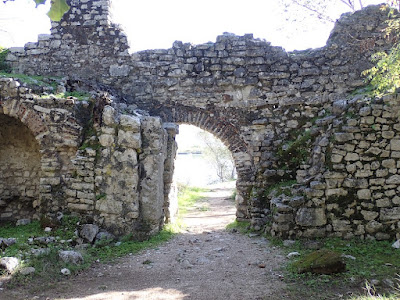 government has been working with various archaeological
institutions around the world to assist with this excavation.
government has been working with various archaeological
institutions around the world to assist with this excavation.
Our
group of maybe 35 people hiked up hills, clambered around the ruins, scuttled
under low gates, and lumbered down ancient stone stairways, trying to see
everything.  The cruise line’s
description said this was a strenuous excursion, and that it was! But it was fascinating to see all these
ruins, the various styles of architecture typical of the different time periods
and cultures of the people who built here.
Some of the walls made from the huge stones don't even use mortar, the stones are just fitted together that tightly!
The cruise line’s
description said this was a strenuous excursion, and that it was! But it was fascinating to see all these
ruins, the various styles of architecture typical of the different time periods
and cultures of the people who built here.
Some of the walls made from the huge stones don't even use mortar, the stones are just fitted together that tightly!
Also, Butrint is full of green shady trees, so while we had a sunny day, it wasn’t very hot as we were hiking up and down hills.
Eventually, we returned back to the beginning of the complex. There was a small museum, as well as a gift shop area where women sold traditional fiber crafts. We headed on to a nice restaurant/bar sort of place, where our group was given a snack of traditional Albanian foods – mezzes, the tasty little Mediterranean appetizers. We had traditional cheeses, a little sausage wrapped in phyllo dough, and my favorite, borek, the creamy cheese-filled phyllo. (I later learned that the cheese is often feta mixed with Greek yogurt, which is why it’s so thick and creamy. And boreks can be made in various shapes – we had the kind where it is baked in a large pan and cut into squares.)
On our drive back to the cruise ship, which took a bit longer due to traffic in Sarandë, Demir talked a bit about the history and politics of Albania, the somewhat recent change from the time when the nation was a closed Communist stronghold to its current Socialist republic government. He also talked about the educational system, and the changes being made culturally as this once closed society moves into the modern era.
It really was a wonderful excursion, even if many of us were pretty tired by the end. I also know I was not the only one who took a nap that afternoon – that evening I ran into a few people I recognized from the trip and several said that yes, they napped in the afternoon. It was quite a bit of exercise!
But we were all happy, having learned more about this fascinating archaeological site, as well as this previously unknown country.
And because I try to always include a photo of the flag of each nation, Albania has a very impressive flag, a red field with a black double-headed eagle! I know nothing about the symbolism, and didn’t get a chance to ask. But it definitely looks like a heraldic flag!
So I had to look it up – the double-headed eagle flag, black on a red field, was the flag of Prince Skanderbeg, the national hero of Albania. In 1443, he raised this flag, his flag, in defiance of the Turks who ruled the country. Prince Skanderbeg and his compatriots were able to resist the Ottoman Empire, although after his death in 1468, the nation was once again under Ottoman rule.
Albanian immigrants popularized the Skanderbeg story in the 19th century, and brought back his flag. Independence from the Ottoman Empire was finally declared in 1912.
This is from Britannica online: “Albanians refer to themselves as shqiptarë—often taken to mean “sons of eagles,” though it may well refer to “those associated with the shqip (i.e., Albanian) language”—and to their country as Shqipëria.”
Wow, an amazing flag to go along with a fascinating history!
Note: all of the extra large archaeology photos are from Butrint, in chronological order (in which they were built or the era which they represent). The Albanian flag was in Sarandë, as were the marina photos.


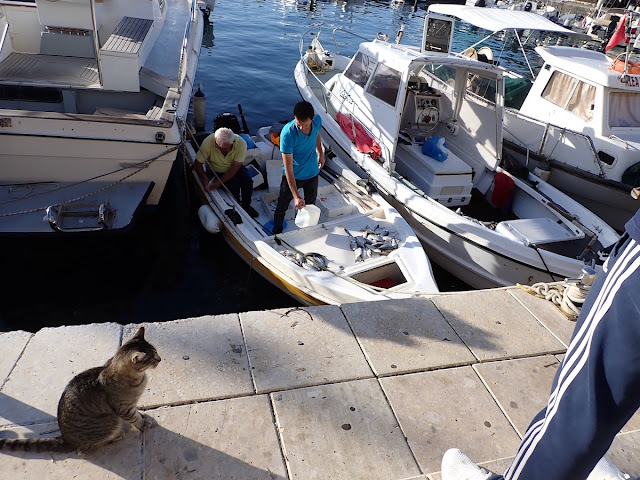



























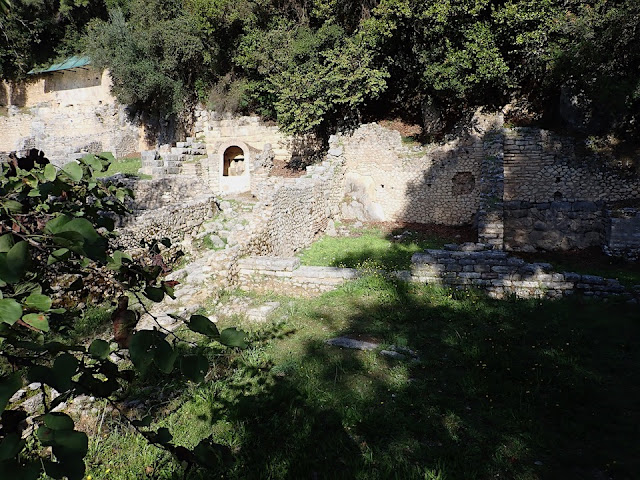


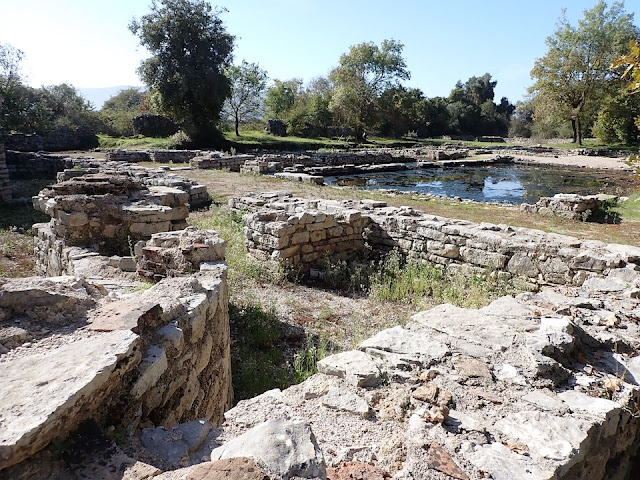


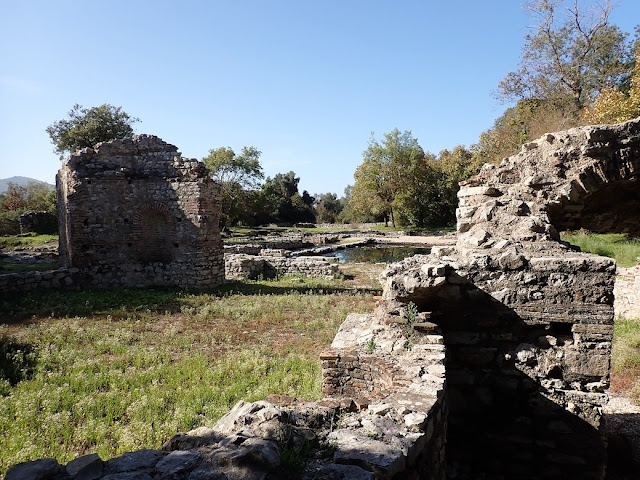





























Thank you for sharing the history of that city! Amazing something that old still remains! Beautiful pictures!
ReplyDeletehugs
barb
1crazydog